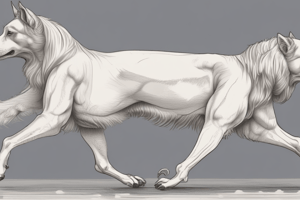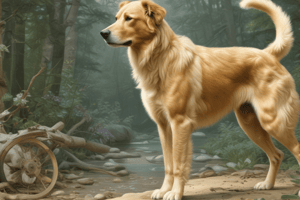Podcast
Questions and Answers
Which scientific advancement most significantly contributed to the detailed study of animal anatomy and physiology during the 17th century?
Which scientific advancement most significantly contributed to the detailed study of animal anatomy and physiology during the 17th century?
- The development of the printing press
- The development of microscopy (correct)
- The discovery of antibiotics
- The invention of the telescope
If a researcher is studying the interactions between a population of deer and the forest ecosystem they inhabit, which branch of zoology is most relevant to this research?
If a researcher is studying the interactions between a population of deer and the forest ecosystem they inhabit, which branch of zoology is most relevant to this research?
- Ethology
- Taxonomy
- Ecology (correct)
- Anatomy
A marine biologist discovers a new species of invertebrate with radial symmetry, stinging cells, and a simple body structure. Which phylum does this organism most likely belong to?
A marine biologist discovers a new species of invertebrate with radial symmetry, stinging cells, and a simple body structure. Which phylum does this organism most likely belong to?
- Porifera
- Mollusca
- Arthropoda
- Cnidaria (correct)
According to the classification system, which level of classification is more inclusive (broader) than Family but less inclusive (more specific) than Class?
According to the classification system, which level of classification is more inclusive (broader) than Family but less inclusive (more specific) than Class?
To which of the following groups does the study of reptiles and amphibians belong?
To which of the following groups does the study of reptiles and amphibians belong?
Which characteristic is unique to animals in the phylum Arthropoda and contributes most to their diversity and ecological success?
Which characteristic is unique to animals in the phylum Arthropoda and contributes most to their diversity and ecological success?
A paleontologist discovers a fossil of an ancient vertebrate. Which branch of zoology would they consult to classify this animal based on its fossilized remains?
A paleontologist discovers a fossil of an ancient vertebrate. Which branch of zoology would they consult to classify this animal based on its fossilized remains?
If you are comparing the digestive systems of lions and zebras, which field of zoology is most applicable to this kind of comparative analysis?
If you are comparing the digestive systems of lions and zebras, which field of zoology is most applicable to this kind of comparative analysis?
Which phylum exhibits the characteristic of having a soft body, which is often protected by a shell?
Which phylum exhibits the characteristic of having a soft body, which is often protected by a shell?
A scientist is conducting research on the genetic mutations that lead to coat color variation in domestic cats. Which branch of zoology is the scientist primarily working in?
A scientist is conducting research on the genetic mutations that lead to coat color variation in domestic cats. Which branch of zoology is the scientist primarily working in?
Which characteristic is unique to chordates at some point during their development?
Which characteristic is unique to chordates at some point during their development?
What is the primary function of the dorsal hollow nerve cord in chordates?
What is the primary function of the dorsal hollow nerve cord in chordates?
How does the respiratory system directly support the function of the circulatory system in animals?
How does the respiratory system directly support the function of the circulatory system in animals?
Which class of vertebrates is characterized by having a cartilaginous skeleton?
Which class of vertebrates is characterized by having a cartilaginous skeleton?
What is the primary role of the integumentary system in animals?
What is the primary role of the integumentary system in animals?
How do learned behaviors differ from innate behaviors in animals?
How do learned behaviors differ from innate behaviors in animals?
What is the significance of migration in animal behavior?
What is the significance of migration in animal behavior?
How does the concept of 'niche' differ from 'habitat' in animal ecology?
How does the concept of 'niche' differ from 'habitat' in animal ecology?
In the context of animal ecology, what does 'symbiosis' refer to?
In the context of animal ecology, what does 'symbiosis' refer to?
What is the primary focus of conservation zoology?
What is the primary focus of conservation zoology?
Flashcards
Zoology
Zoology
The scientific study of animals, including their anatomy, behavior, and evolution.
Aristotle's Role in Zoology
Aristotle's Role in Zoology
Considered an early zoologist, known for detailed animal observations.
Morphology
Morphology
The study of the form and structure of animals.
Anatomy
Anatomy
Signup and view all the flashcards
Taxonomy
Taxonomy
Signup and view all the flashcards
Paleontology
Paleontology
Signup and view all the flashcards
Animal Classification
Animal Classification
Signup and view all the flashcards
Porifera
Porifera
Signup and view all the flashcards
Cnidaria
Cnidaria
Signup and view all the flashcards
Arthropoda
Arthropoda
Signup and view all the flashcards
What is a notochord?
What is a notochord?
Signup and view all the flashcards
What is the dorsal hollow nerve cord?
What is the dorsal hollow nerve cord?
Signup and view all the flashcards
What are pharyngeal slits or clefts?
What are pharyngeal slits or clefts?
Signup and view all the flashcards
What is a muscular post-anal tail?
What is a muscular post-anal tail?
Signup and view all the flashcards
What are Agnatha?
What are Agnatha?
Signup and view all the flashcards
What are Chondrichthyes?
What are Chondrichthyes?
Signup and view all the flashcards
What are Osteichthyes?
What are Osteichthyes?
Signup and view all the flashcards
What are Amphibia?
What are Amphibia?
Signup and view all the flashcards
What are Aves?
What are Aves?
Signup and view all the flashcards
What are Mammalia?
What are Mammalia?
Signup and view all the flashcards
Study Notes
- Zoology is the scientific study of animals
- It encompasses the study of animal anatomy, physiology, behavior, genetics, ecology, evolution, and conservation
History of Zoology
- Aristotle is considered one of the earliest and most influential zoologists, with detailed observations of animal life
- The development of microscopy in the 17th century opened new avenues for studying animal anatomy and physiology
- Charles Darwin's theory of evolution by natural selection revolutionized zoology in the 19th century
Major Branches of Zoology
- Morphology is the study of the form and structure of animals
- Anatomy is a branch of morphology that focuses on the internal structure of animals, often through dissection
- Physiology studies the functions and processes of animal bodies
- Ethology is the scientific study of animal behavior
- Ecology examines the interactions between animals and their environment
- Taxonomy is the science of classifying and naming organisms, including animals
- Paleontology is the study of prehistoric life, including animal fossils
- Genetics explores heredity and variation in animals
- Molecular biology investigates the biological activity at a molecular level
- Entomology is the study of insects
- Herpetology focuses on reptiles and amphibians
- Ichthyology is the study of fishes
- Ornithology focuses on birds
- Mammalogy is the study of mammals
Animal Classification
- Animals are classified into a hierarchical system, starting with broad categories and becoming more specific
- The major ranks in animal classification are: Domain, Kingdom, Phylum, Class, Order, Family, Genus, and Species
- The animal kingdom (Animalia) includes a vast diversity of multicellular, eukaryotic organisms
Animal Phyla
- Porifera (sponges) are simple, aquatic animals with porous bodies
- Cnidaria (jellyfish, corals, sea anemones) are characterized by radial symmetry and stinging cells called cnidocytes
- Platyhelminthes (flatworms) include free-living and parasitic forms with bilateral symmetry
- Nematoda (roundworms) possess a cylindrical body shape and are found in diverse habitats
- Annelida (segmented worms) exhibit body segmentation and include earthworms, leeches, and polychaetes
- Mollusca (snails, clams, squids) are a diverse group with a soft body, often protected by a shell
- Arthropoda (insects, spiders, crustaceans) are the most diverse animal phylum, characterized by an exoskeleton and jointed appendages
- Echinodermata (sea stars, sea urchins) are marine animals with radial symmetry and a water vascular system
- Chordata includes vertebrates (animals with a backbone) and several invertebrate groups
Key Characteristics of Chordates
- Notochord: A flexible rod that provides support
- Dorsal hollow nerve cord: Develops into the brain and spinal cord
- Pharyngeal slits or clefts: Structures in the pharynx region that may develop into gills or other structures
- Muscular post-anal tail: A tail that extends beyond the anus
Vertebrate Classes
- Agnatha (jawless fishes) are represented by lampreys and hagfishes
- Chondrichthyes (cartilaginous fishes) include sharks, rays, and skates
- Osteichthyes (bony fishes) are the most diverse group of fishes, with a bony skeleton
- Amphibia (amphibians) include frogs, toads, and salamanders, which typically undergo metamorphosis from aquatic larvae to terrestrial adults
- Reptilia (reptiles) include lizards, snakes, turtles, and crocodiles, which are adapted to terrestrial life
- Aves (birds) are characterized by feathers, wings, and beaks, and are adapted for flight
- Mammalia (mammals) possess mammary glands, hair, and typically give birth to live young
Animal Anatomy and Physiology
- The integumentary system (skin) provides protection, regulates temperature, and aids in sensation
- The skeletal system provides support, protects organs, and enables movement
- The muscular system enables movement through contraction of muscle tissues
- The nervous system coordinates and controls body functions through electrical and chemical signals
- The endocrine system regulates body functions through hormones
- The circulatory system transports oxygen, nutrients, and wastes throughout the body
- The respiratory system facilitates gas exchange (oxygen and carbon dioxide)
- The digestive system breaks down food and absorbs nutrients
- The excretory system removes metabolic wastes from the body
- The immune system defends the body against pathogens and other foreign substances
- Osmoregulation is the process of maintaining water and salt balance in the body
- Thermoregulation is the process of maintaining body temperature
- Reproduction is the process by which animals produce offspring, either sexually or asexually
Animal Behavior
- Innate behaviors are genetically programmed and performed without prior experience
- Learned behaviors are acquired through experience and can be modified over time
- Communication includes visual, auditory, chemical, and tactile signals
- Social behavior involves interactions between individuals, including cooperation, competition, and altruism
- Mating behavior includes courtship rituals, mate selection, and parental care
- Migration is the seasonal movement of animals from one region to another
- Foraging behavior involves the search for and acquisition of food
Animal Ecology
- Population ecology studies the size, density, distribution, and dynamics of animal populations
- Community ecology examines the interactions between different animal species in a community
- Ecosystem ecology explores the flow of energy and nutrients through ecosystems
- Habitat is the natural environment in which an animal lives
- Niche is the role and position an animal occupies in its environment
- Predation is the interaction between predator and prey
- Competition occurs when animals compete for limited resources
- Symbiosis is a close and long-term interaction between different species
- Conservation zoology focuses on protecting endangered species and their habitats
Studying That Suits You
Use AI to generate personalized quizzes and flashcards to suit your learning preferences.




